Figures & data
FIGURE 1 Location and biochronology of early Miocene bothriodotines discussed in this study. A, cf. Arretotherium fricki from the early Hemingfordian Cypress Hill Formation in Saskatchewan (Storer and Bryant, Citation1993); B, A. fricki Macdonald and Shultz, Citation1956, from the early Hemingfordian Upper Marsland Formation in Nebraska and also present in the Hemingfordian Flint Hill L. F. from South Dakota (Macdonald and Shultz, Citation1956; Macdonald and Martin, Citation1987); C, A. leptodus (= Ancodon leptodus) Matthew, Citation1909, from the early Arikareean Lower Rosebud beds, South Dakota (Scott, Citation1940; Macdonald, Citation1956; Macdonald, Citation1963; Tedford et al., Citation2004); D, A. acridens Douglass, Citation1901, from the early Arikarrean Blacktail Deer Creek Fauna., Montana (Hibbard and Keenmon, Citation1950); E, Kukusepasutanka Macdonald, Citation1956, from the late Arikareean deposits of Montana (Macdonald, Citation1956); F, Arretotherium acridens Douglass, Citation1901, from the early Miocene Toledo Bend L. F., Texas (Albright, Citation1999); G, A. meridionale, sp. nov., from the Las Cascadas fossil assemblage, Panama. Chronostratigraphy and biochronology modified from Albright et al. (Citation2008). Abbreviations: Ar, Arikareean Faunal Zone; E, early; L, late; L. F., Local Fauna.
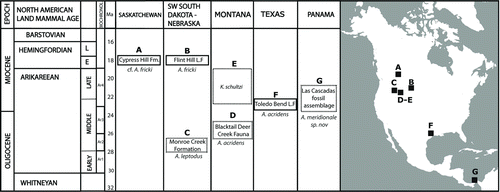
FIGURE 2 Location and stratigraphic position of fossil bothriodontines from the Gaillard Cut, Panama Canal area. A, map of North and Central America showing the location of the Panama Canal area and the Gaillard Cut. B, stratigraphic position of the Las Cascadas fossil assemblage and the Centenario Fauna. Modified from Kirby et al. (Citation2008), MacFadden et al. (Citation2010), and Montes et al. (Citation2012).
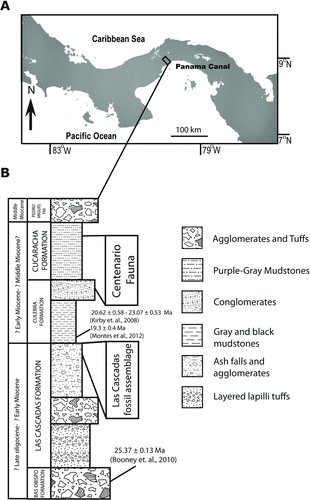
FIGURE 3 Diagram showing most of the dental cusp nomenclature applied to lower permanent dentitions of anthracotheres in this study. Abbreviations: dlmtcid , distolingal metacristid; Entd , entoconid; Hypd , hypoconid; Hypulid , hypoconulid; mletcid , mesiolingual entoconid; mlmtcid , mesiolingual metacristid; Metd , metaconid; poetcid , postentoconulid; pohypid , posthypoconid; pometid , postmetacristid; poptcid , postprotocristid; peetcid , preentocristid; pehypid , prehypocristid; pemtcid , premetacristid; peptcid , preprotocristid; Ptcd , protoconid. Modified from Lihoreau and Ducrocq (Citation2007).
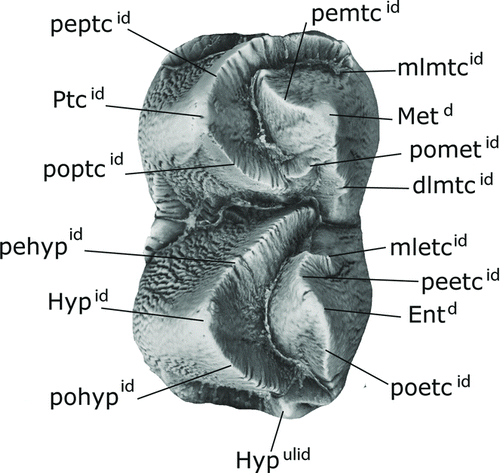
FIGURE 4 Lower dentition of Arretotherium meridionale, sp. nov. A, UF 244187, juvenile left dentary with left dc1, partially erupted left canine, p1, dp2–dp4, m1–m2, and associated right i1–i2 and mandibular symphysis, occlusal view; B, lingual view; C, labial view; D, associated right i1, lingual view; E, labial view; F, associated right i2, lingual view; G, labial view; H, detailed view of the anterior part of UF 244187 showing the erupting Lc1. Abbreviations: pehypid , prehypocristid; postlgF, posterolingual furrow; antlgF, anterolingual furrow.
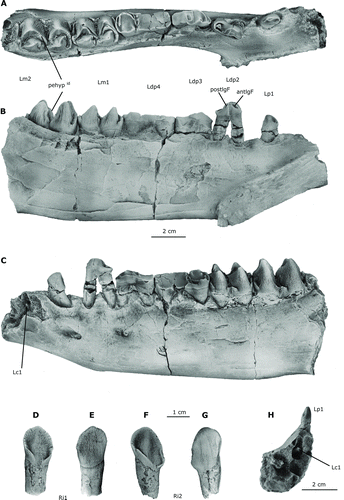
FIGURE 5 Detailed view of the lower permanent dentition of Arretotherium meridionale, sp. nov. A, UF 244187, left m1–m2, lingual view; B, occlusal view; C, X-ray detailed image of the anterior part of UF 244187 showing the erupting permanent Lc1. Abbreviations: pehypid , prehypocristid; mlmtcid , mesiolingual metacristid; peetcid , preentocristid; pometid , postmetacristid; hypulid , hypoconulid.
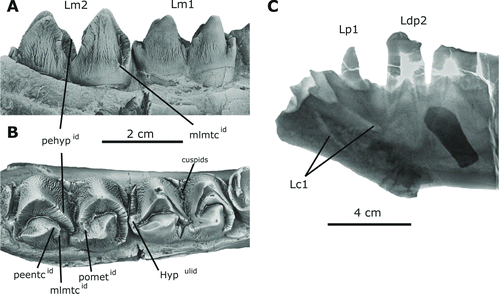
TABLE 1 Summary of dental measurements (in mm) of A. meridionale, sp. nov., from the Las Cascadas Formation.
FIGURE 6 Upper dentition of Arretotherium meridionale, sp. nov. A, UF 244295, left upper canine, lingual view; B, occlusal view; C, UF 245609, right upper incisor (Ix), labial view; D, lingual view; E, UF 244174, partial left M3, occlusal view.
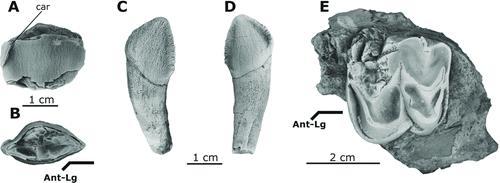
TABLE 2 Summary table of the anterior–posterior length (APL) and maximum transverse width (MTW) of m1 and M3 for relevant specimens of Arretotherium.
FIGURE 7 Biogeographic distribution and hypothesized phylogenetic relationships (calculated in PAUP 4.0b10) of Anthracotheriidae including Arretotherium meridionale, sp. nov., and A. acridens from the Toledo Bend L. F. (Albright, Citation1999). Data matrix includes 51 characters and 28 ingroup taxa; Siamotherium krabinese as the outgroup (modified from Lihoreau and Ducrocq, Citation2007). Pictured here is the strict consensus tree of the six most parsimonious trees resulted from the equally weighted branch-and-bound search (tree length = 120; CI = 0.583, RI = 0.829, HI = 0.41). At each node (bold numbers), the supporting unambiguous synapomorphies are 1, Antracotheriidae (20[1]); 2, Anthracotheriinae (7[1], 19[1]); 3, (18[1], 25[1], 35[1]); 4, (36[1]); 5, (16[1], 34[1], 38[1]); 6, Microbunodontinae (5[1], 6[1], 33[1]); 7, (26[1], 27[1], 32[1], 39[1], 40[1]; 8, (20[0], 37[1]); 9, Bothriodontinae (6[2], 17[1], 23[1], 39[2]); 10, (26[1], 27[1]); 11, (1[2], 2[2], 3[1], 4[2], 14[1], 20[0], 28[1], 44[2]); 12, (17[2], 18[1], 29[1], 35[1]); 13, (4[1], 33[1]); 14, (6[0], 7[1], 8[3], 24[1], 38[2], 39[1]); 15, (12[1]); 16, (20[0], 45[1]); 17, (4[1], 18[0]); 18, (6[1], 24[0]); 19, (11[1], 14[1], 23[0], 35[0], 44[1]); 20, (13[1], 21[1]); 21, (41[1]); 22, (18[0], 28[1]); 23, (39[0]); 24, (17[3], 40[2]); 25, (1[1], 9[2], 10[1], 11[2], 30[1], 31[1], 42[1], 49[1].
![FIGURE 7 Biogeographic distribution and hypothesized phylogenetic relationships (calculated in PAUP 4.0b10) of Anthracotheriidae including Arretotherium meridionale, sp. nov., and A. acridens from the Toledo Bend L. F. (Albright, Citation1999). Data matrix includes 51 characters and 28 ingroup taxa; Siamotherium krabinese as the outgroup (modified from Lihoreau and Ducrocq, Citation2007). Pictured here is the strict consensus tree of the six most parsimonious trees resulted from the equally weighted branch-and-bound search (tree length = 120; CI = 0.583, RI = 0.829, HI = 0.41). At each node (bold numbers), the supporting unambiguous synapomorphies are 1, Antracotheriidae (20[1]); 2, Anthracotheriinae (7[1], 19[1]); 3, (18[1], 25[1], 35[1]); 4, (36[1]); 5, (16[1], 34[1], 38[1]); 6, Microbunodontinae (5[1], 6[1], 33[1]); 7, (26[1], 27[1], 32[1], 39[1], 40[1]; 8, (20[0], 37[1]); 9, Bothriodontinae (6[2], 17[1], 23[1], 39[2]); 10, (26[1], 27[1]); 11, (1[2], 2[2], 3[1], 4[2], 14[1], 20[0], 28[1], 44[2]); 12, (17[2], 18[1], 29[1], 35[1]); 13, (4[1], 33[1]); 14, (6[0], 7[1], 8[3], 24[1], 38[2], 39[1]); 15, (12[1]); 16, (20[0], 45[1]); 17, (4[1], 18[0]); 18, (6[1], 24[0]); 19, (11[1], 14[1], 23[0], 35[0], 44[1]); 20, (13[1], 21[1]); 21, (41[1]); 22, (18[0], 28[1]); 23, (39[0]); 24, (17[3], 40[2]); 25, (1[1], 9[2], 10[1], 11[2], 30[1], 31[1], 42[1], 49[1].](/cms/asset/c51d26fd-c682-4cc1-b604-a9001ae42a76/ujvp_a_722573_o_f0007g.gif)